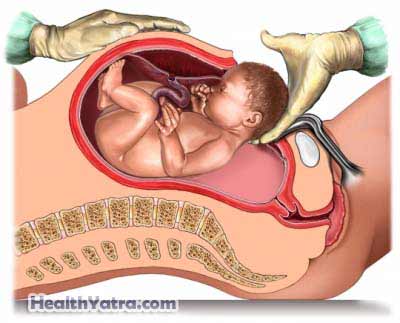Definition
In a cesarean birth (C-section), the baby is delivered through an incision in the mother’s abdomen. In the United States, some estimates suggest almost half of all births are delivered by C-section.

Reasons for Procedure
The following situations may require a C-section:
- Large baby
- Pregnancy with twins or more
- Baby is not in a head-down position
- Maternal medical conditions, for example, diabetes, high blood pressure, active herpes infection, or HIV-positive
- Problem with the position of the placenta
- Failure of labor to progress
- Baby shows signs of distress, such as an abnormal heart rate during labor
- Previous cesarean birth
- Fetal problems
Possible Complications
Cesarean birth is a surgery. There are some risks involved. The estimated risk of a woman dying after a cesarean birth is extremely small. The risk of death after a vaginal birth is even smaller. Other risks include:
- Infection
- Bleeding
- Decreased bowel function
- Damage to other organs in the abdomen
- Longer hospital stay and recovery time
- Bad reactions to anesthesia
- Risk of additional surgeries, including hysterectomy, bladder repair, or repeat C-sections with future pregnancies.
Factors that may increase the risk of complications include:
- Prior cesarean section
- Prior surgery of the uterus
- Abnormal placenta
- Smoking
Cesarean birth also has risks for babies. Babies born prematurely have more risks. The risk of death for premature babies delivered by elective C-section is very small. The risk of death for premature babies born vaginally is even smaller.
What to Expect
Prior to Procedure
C-sections are often unplanned. If you have a scheduled C-section, you may be asked not to eat or drink after midnight before the procedure.
Anesthesia
You may be given:
- General anesthesia —You will be asleep.
- Regional anesthesia such as epidural or spinal block —An area of your body will be numb, but you will be awake.
Many women prefer regional anesthesia so that they can be awake to see their new baby.
Description of the Procedure
Your doctor will make incisions in your abdominal skin and womb.
After the incisions are made, the baby will be delivered. Your uterus will be closed with stitches that later dissolve on their own. Staples could also be used to close the abdomen.
Immediately After Procedure
Your baby will be examined. You may be able to hold your baby. It will depend on the condition of you and your baby.
How Long Will It Take?
45-60 minutes
Will It Hurt?
Anesthesia prevents pain during the surgery. You may feel some pressure and tugging as the uterus is opened and the baby and placenta are removed. You will receive pain medicines while you recover. They will help you manage your pain and discomfort.
Average Hospital Stay
3-5 days
Post-procedure Care
At the Hospital
- Very soon after birth, your baby may be placed on your chest. This skin-to-skin contact may lead to improved breastfeeding success.
- You may need help learning breastfeeding positions. The correct position will keep you from putting too much pressure on your incision.
- You may need medicine to help with nausea or pain.
- You will likely experience some uterine cramping and pain.
- Your bowels will work more slowly than usual. You may need to eat a light diet at first. Chewing gum may help speed the process of your bowel function returning to normal.
- You may be given special compression stockings. They will help to decrease the possibility of blood clots forming in your legs.
- For lung health, you may be asked to use an incentive spirometer and cough often. These steps will help you breathe deeply.
- You will be encouraged to walk very soon after surgery. You will be asked not to lift anything heavier than your baby.
- After any delivery, there will be moderate-to-heavy vaginal bleeding. You will need to use an absorbent sanitary napkin.
- You may be on a clear liquid diet after surgery. You will advance to a normal diet as you are able.
At Home
When you return home, do the following to help ensure a smooth recovery:
- Avoid lifting anything heavier than your baby for the first weeks after surgery.
- Do not drive until your doctor says it is all right to do so.
- Ask your doctor when it is safe to shower, bathe, or soak in water.
- Delay having sexual intercourse or putting any objects in the vagina until you have had your 6-week check-up.
- Breastfeeding is encouraged.
- Consider joining a support group for new mothers. You can get encouragement and learn new parenting strategies.
- Be sure to follow your doctor’s instructions .
You should heal quickly and completely after a C-section. Talk with your doctor about the type of incisions used during your procedure. It may play a role in decisions about future births.
Call Your Doctor
After you leave the hospital, contact your doctor if any of the following occurs:
- Signs of infection, including fever and chills
- Excessive bleeding, redness, swelling, increasing pain, or discharge from the incision site
- Nausea and/or vomiting that you cannot control with the medicines you were given after surgery, or which persist for more than two days after discharge from the hospital
- Pain that you cannot control with the medicines you have been given
- Swelling and/or pain in one or both legs
- Cough, shortness of breath, or chest pain
- Joint pain, fatigue, stiffness, rash, or other new symptoms
- Dizziness or faintness
- Heavy vaginal bleeding
- Foul-smelling vaginal discharge
In case of an emergency, call for medical help right away.
